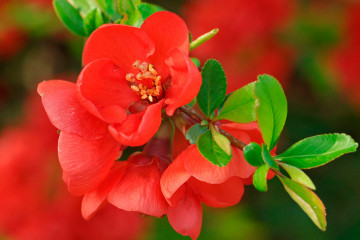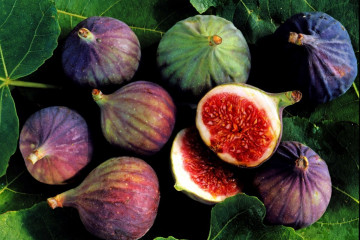Viburnum red is a shrub or tree, - description
Content:
The plant, known as Viburnum, or Viburnum, belongs to the distinct Viburnum species, the Dicotyledonous class. It is prized for its fruits and bark, which are widely used in traditional medicine. In the wild, it is found in most regions of the temperate zone, and many fertile and beautifully flowering varieties have been bred in the culture.
Viburnum - tree or shrub
It depends on how to form the crown at an early stage of development. For a tree, a height of up to 4 m is typical, and for shrubs - up to 1.5 m. In both cases, the life expectancy is about 50 years or a little longer.
What does red viburnum look like?
Previously, the plant was attributed to the family of Honeysuckle (Caprifoliaceae), which can be found in the scientific literature. Currently, the viburnum shrub is described as part of the Adoxaceae family.
The bark is gray-brown, which has numerous longitudinal cracks. Shoots are round, glabrous. The leaf is dark green petiolate, broadly ovate, up to 10 cm long and up to 8 cm wide, has 3-5 pointed lobes. Flat umbellate panicles are located at the ends of young shoots. Usually, white flowers bloom in late May and can bloom for up to 25 days, but more often up to two weeks. The fruit is a red rounded drupe up to 10 cm in diameter with a single stone inside a somewhat herbaceous sweet and sour taste, which ripens from August to October. Seeds remain viable for up to two years.
Healing properties
Ripe fruits are harvested and dried, after which they are used for medicinal purposes. Kalina is the record holder for the amount of all kinds of vitamins and microelements (per 100 g of berries):
- ascorbic acid - up to 80-135 mg;
- nicotinic acid - up to 1350 mg;
- carotene - 2.5 mg;
- vitamin K - up to 30 mg;
- folic acid - up to 0.03 mg;
- molybdenum - 240 mg;
- selenium - 10 mg;
- manganese - 6 mg;
- iron - 0.3 mg.
The fruits are recommended for people suffering from metabolic disorders, with pathologies of the cardiovascular system and the digestive tract. The child can drink decoctions and various culinary products with viburnum without restrictions.
Briefly about the history of appearance
Viburnum has been used in medicine and cooking for many centuries. In European herbalists, it, as a medicinal plant, has been mentioned since the XIV century, and in Ancient Russia, fruit juice was used as an anti-cancer agent.
The selection of cultivated varieties followed the path of improving the properties of berries. In comparison with wild-growing, they have a sweeter taste. In decorative gardening and landscape design, the variety Gordovina (Viburnum Lantana) is well known, whose fruits are inedible, but flowering and crown are very beautiful. The buldenezh species does not bear fruit, but within a month it pleases the eye with huge snow-white inflorescences. Among the sweet-fruited varieties, the most famous for this characteristic is Red Coral.
Care features
Since cultural varieties genetically have not gone far from wild-growing predecessors, caring for a shrub or tree-like form is quite simple.In the spring, immediately after the snow melts, adult plants are pruned, removing broken and dry branches and giving the crown the desired shape.
In May, 50 g of nitroammofoska is applied under each bush, and a thick layer of mulch is also poured in to keep the soil moist for as long as possible. The second feeding is done at the end of flowering. You can add organic matter, wood ash, complex mineral fertilizer. If the number of rains in summer is high, then watering is not required, and in hot areas the trees are watered every week.
In autumn, the fruits are harvested with brushes, waiting for full ripeness, even in frost. The ripening signal is a change in the structure of the berries. When pressed, they secrete scarlet juice.
Immediately after harvesting, 20 g of potassium salt and superphosphate are applied under the trees.
When and how red viburnum blooms (shrub)
In most regions, viburnum buds bloom in the last decade of May or a little later, depending on the weather. The shade of the petals is not only white, but also yellowish or pinkish in different varieties.
In decorative varieties, the inflorescences are in the shape of a ball up to 20 cm in diameter. Their scent is heard from afar. The flowering period can be up to 35 days. At this time, bees flock to flowering plants from all over the area.
How red viburnum reproduces
In the spring, it is best to purchase a cultivar seedling in a nursery. This will allow you to get a beautiful flowering or valuable fruits in the very first year. In addition, viburnum is propagated by seeds and cuttings.
Germinating seeds
The method is rarely used due to its high labor intensity. The order is as follows:
- Fresh seeds are mixed with wet sawdust and kept at room temperature for two months, moistening again as they dry.
- As soon as the first bones hatch, the entire volume is collected and transferred to the refrigerator, where they are kept for a month.
- Germinated seeds are sown in boxes with soil to a depth of 3-4 cm and wait for the sprouts to appear.
- In May, when the threat of frost has completely passed, the seedlings are planted in their permanent places, watering regularly.
Rooting cuttings
Cuttings are harvested in June, when they are elastic, not brittle. Cut off the tops of shoots 10-12 cm long with 2-3 nodes. The lower leaves are removed, and the upper ones are shortened by half.
The cutting is planted in a mixture of peat and sand. The tip is deepened by 1-2 cm at an angle. Then it is covered with a transparent cap and kept at a temperature of about 27-30 ° C. Then 3-4 times a day the cap is raised to spray the viburnum with warm water.
Transfer
A planting hole for a three-year-old seedling is dug 50 × 50 cm in size and 50 cm deep. 2.5-3.5 m are left between the plants. A mixture of excavated soil with humus and peat is poured at the bottom. Pour four buckets of water and leave for a week.
Then the remaining soil is poured with a slide so that the crown protrudes from the pit. The roots of the seedling are spread on top and a peg for a garter is stuck in. Pour the remaining soil over the roots and pour 1-2 buckets of water. A thick layer of peat mixed with compost and humus is poured on top so that the root collar disappears by 5-6 cm.
A viburnum bush that has taken root on the site will eventually require a minimum of attention to itself, every year delighting with an increasing harvest of useful berries. Shade tolerance allows you to set aside almost any free area in the garden for planting, and many are planted behind a fence, because the plant looks beautiful all year round.


















